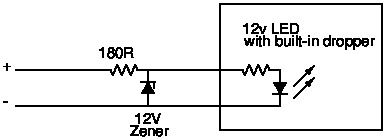Posted by Andrew Johnston on 15/08/2020 15:45:12:
Posted by Tim Stevens on 15/08/2020 14:58:49:
The problem is that diodes do not cope well with spikes – of an unknown voltage* and very short duration, caused by the collapse of the field in the ignition coil as it it switched off every half a revolution.
I've read this thread through twice and I can't see any evidence that points to the problem being ignition pick up. …
There's an art to solving these sort of problems and the first step is to gather data without making any guesses at what is causing the problem. …
If I've got it correct some other LEDs flicker when the car is started/running which is suspected to be due to variations on the DC supply. It would be useful to quantify those variations…
…
Andrew
Andrew is right about the need for more evidence, and his point about ignition pick up being unlikely is well made!
In that case, the other suspect is the car's electrical system.
Tim explained: 'The vehicle is a 1928 Lea Francis model P 12/40 coupe-cabriolet. The dynamo is CAV driven at 1.5 wengine speed as original, and the voltage regulator came from a British supplier whose details I have, but not handy at 11.pm – sorry. It has been converted to a two-brush system in place of the original 3-brush which was controlled by the driver when he remembered and turned the dynamo on, or off (ie too much or not enough). '
Tim describes a pre-war dynamo system with a relay based regulator. Though clever these crude regulators are a long way from the smooth volts supplied by a modern alternator system. The regulators relays control voltage and current by switching a resistor as necessary to increase or decrease current flowing in dynamo's field coil. A third relay cut-outs the battery to prevent overcharging. Correct on average, like the rpm of a hit and miss engine.
Could be three unsuppressed relays putting inductive spikes on the output. My chief suspect though is the rough voltage regulator itself. It's notion of '12v' is undoubtedly crude, plus a relay has slow reactions, meaning volts could rise quite high before the field current drops. I guess the relay kicks in and out more or less continuously too, putting a series of spikes on the output. Filament bulbs and the battery are unlikely to mind, but LEDs are voltage sensitive.
Suggests a cure as per Robert's Zener, just in front of the Tim's 12v LED, eg.

The circuit is a simple voltage stabiliser, with the Zener shorting out anything over 12v. Self criticism, the zener and 180 ohm resistor powering the oil-pressure gauge lamp will soaking up whatever excess the dynamo happens to be chucking out. Might need to be generously rated. An oscilloscope would reveal all.
A better solution would be to put a modern stabilised power supply across the dynamo and use it to provide clean power to anything remotely modern on the car. I think the box I recommended earlier has a good chance of fixing Tim's problem.
Might I have seen Tim's car on TV? Just the job for Downton Abbey!
Dave
PS,
I see Tim posted just before I hit send, and maybe he's added an new clue. I'd assumed the LED was being destroyed, which definitely points to spikes. Now I'm wondering if Tim means it goes out temporarily. Does the LED come back on when the sidelights are turned off? Going out temporarily isn't spikes.
Edited By SillyOldDuffer on 15/08/2020 17:24:30
 Michael Gilligan.
Michael Gilligan.






